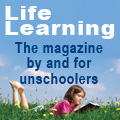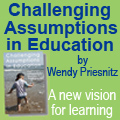|

Dress-Up Play
By Wendy Priesnitz
Dress-up play isn’t just fun for little kids, it’s an important activity where they use their imaginations, build vocabulary skills, gain confidence, and more. With dress-up play, a child can be anyone she likes, from a superhero to a doctor, a baker to a fashion model. Yes, even a princess or a frog.
Dramatic dress-up play is roleplaying and storytelling that helps children develop ideas about how the world works. When they strap on a tool belt, they are trying to figure out what it’s like to be a construction worker. Or they put on your high heels and skirt, and grab some props like a purse and a doll, acting out what they think it’s like to be a mommy. And there are many other benefits too.
Physical Development
Gross motor skills will be developed when your child uses large muscles running and jumping, casting a line like a fisherman, running and dodging like a football player, or leaping like a dancer. Dramatic play also allows children to practice fine motor coordination by buttoning a jacket, tying on an apron, fashioning a cape from a piece of material, and so on.
Social Skills
Dress-up play encourages interaction and communication with others. It often becomes cooperative as your child interacts and communicates about what their doing. Role playing encourages teamwork and an interest in other children and what they’re thinking and doing. Kids learn to negotiate in this way, to collaborate, take turns, and create and play by the rules. There is also research that has linked role play to empathy: Kids who engaged in it were more skilled in judging how other people might feel than those who didn’t role play as much.
Since role playing usually includes pretend conversations – solo or with others – you will often hear your child using accents and other verbal inflections that they imagine will help them become the person they are dressed up as. This is a great opportunity to develop communication skills. Second language learners especially benefit from this conversational practice.
Life Skills
One mom I spoke with said that her two taught themselves to get dressed – shirts on the right way, shoes on the right feet, buttons and zippers done up – because one day she was baking bread and couldn’t help them with their dress-up costumes right away. In some role playing situations, children pretend to do household chores, like vacuuming, cooking dinner, and taking care of pets. They also try out jobs, learning more about them along the way.
Stretching the Imagination
One of the big – and most obvious – aspects of dress-up play is that it uses a child’s limitless imagination. By imagining themself to be someone different, a child develops their creativity. Using different things in new ways – pretending a piece of cardboard is a sword, a colander is a hard hat, and a long skirt tied at the bottom is a mermaid’s tail – flexes those imagination muscles.
And imagining yourself as a superhero is a way to feel powerful in a world where everyone seems to be controlling the agenda and telling you what to do and how to do it.
Developing Confidence
By dressing up as someone else, children build confidence in themselves. This is an important aspect of growing up to be a secure, emotionally healthy adult. And by encouraging and facilitating role playing, we can nurture that confidence and help them understand that they have the ability to be anybody they want and accomplish anything they desire.
Working Through Experiences and Emotions
When they are in their own little make believe world, children can feel safe enough to explore their emotions. They can use dress-up play to make sense of the world by acting out and working through an experience they have had. So when your daughter pretends her PJs are a doctor’s scrubs and checks her doll’s heartbeat using a pretend stethoscope, she might be reliving something a bit scary that she has experienced in real life. Pay attention to these situations because your child’s dress-up roleplaying can be a window into their mind and give you clues to what is bothering them.
Encouraging Dress-Up Play
You can buy dress-up kits for children, including Halloween costumes. But I think it’s much better for their imaginations (not to mention your budget) if you collect items from your home or the local thrift shop to outfit your family’s dress-up trunk. Here are some ideas for items that can become something else:
- gauzy skirt
- tool belt
- sunglasses and regular glasses with the lenses removed
- hats and long gloves
- aprons and towels
- scarves and shawls
- plastic colander
- belts
- purses, briefcases, luggage
- tutus or dance costumes
Role playing is an important part of children’s growth and development, as well as in their role identification as they grow into adulthood. So help them dream their dreams and let their imagination kick into high gear.
Wendy Priesnitz is the founder and editor of Child's Play Magazine.
Copyright © Life Media
Privacy Policy
 



|

